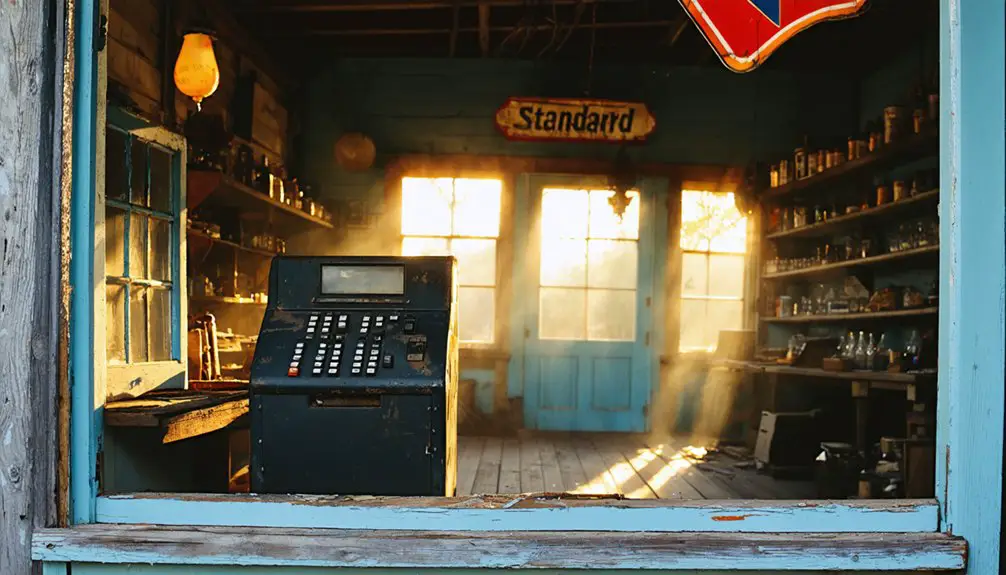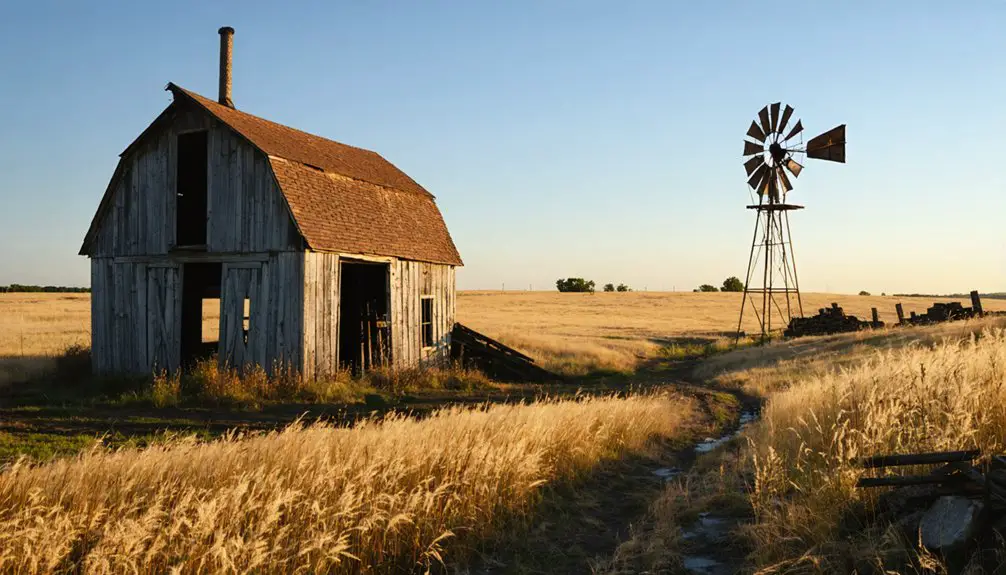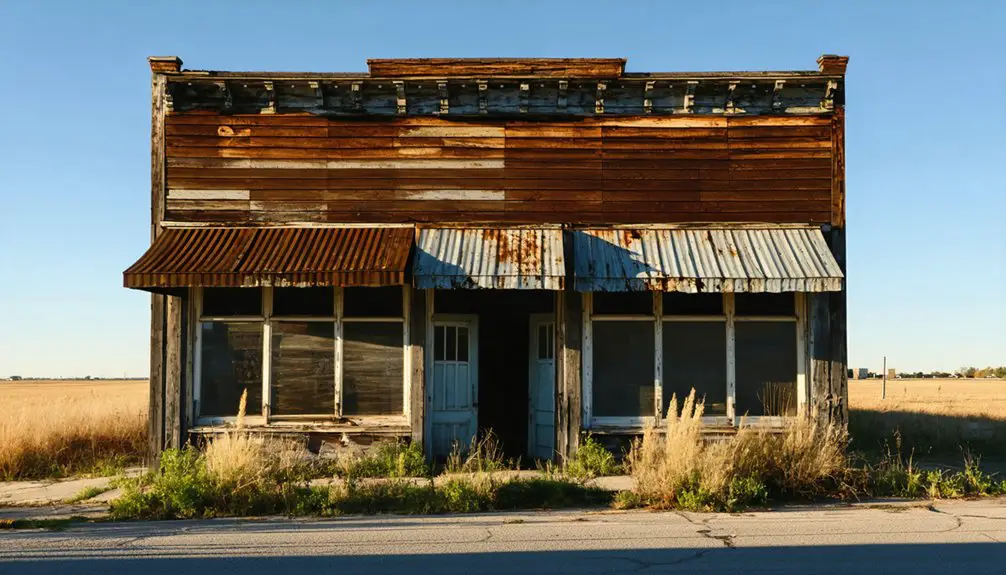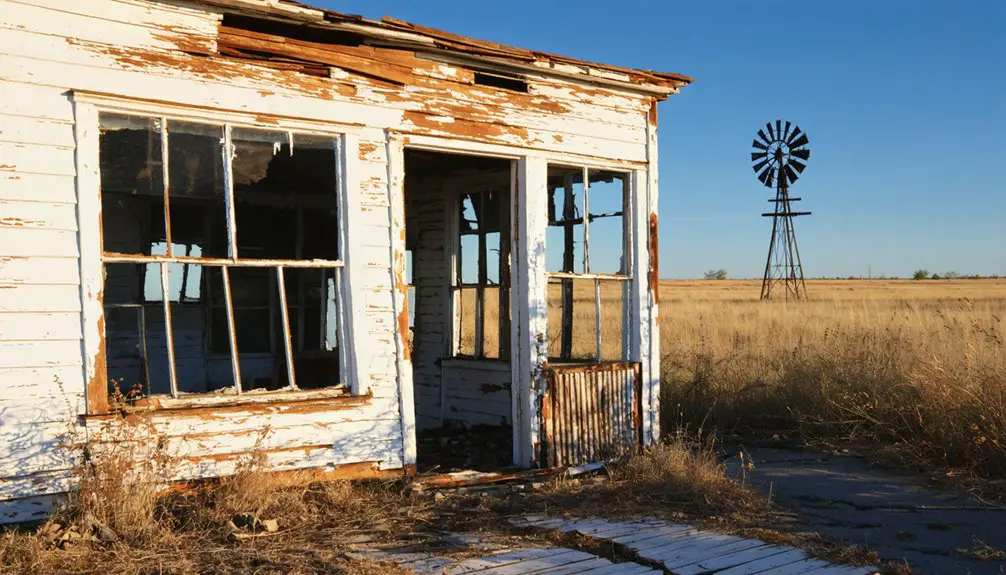You’ll find Maxwell tucked away in Pontotoc County, Oklahoma, where it once thrived as a bustling railroad town at the turn of the 20th century. The ghost town sits between 971-1,020 feet above sea level, accessible via N4292 Rd and E1980 Rd. Today, deteriorating stone buildings and foundations dot the gently rolling plains, marking what remains of this pioneer community. The site’s connection to the Maxwell Land Grant dispute and regional railroad history holds fascinating tales of frontier Oklahoma.
Key Takeaways
- Maxwell is an abandoned town in Pontotoc County, Oklahoma, situated at 34.89453° N and 96.83085° W with elevations between 971-1,020 feet.
- The town began as a bustling pioneer community around a railroad station before Oklahoma statehood, serving agricultural and transportation needs.
- Remaining structures include stone buildings, bank ruins, and the deteriorating Chief Theater, showcasing original architectural details from its heyday.
- The town’s decline was driven by mechanization, urban growth, and shifting transportation patterns from rail to automobile culture.
- Visitors can explore Maxwell’s ruins via rural roads near N4292 Rd and E1980 Rd, though GPS and dry weather conditions are recommended.
Location and Geographic Features
Maxwell, a ghost town in Pontotoc County, Oklahoma, sits at latitude 34.89453° N and longitude 96.83085° W, with an elevation ranging between 971-1,020 feet above sea level.
You’ll find the site within the USGS Konawa quadrangle, where gently rolling plains define the landform characteristics typical of central Oklahoma. To protect against unauthorized access and maintain site integrity, identity verification is required before entering certain preserved areas.
The terrain surrounding Maxwell features mixed grasslands and sparse woodland, with low hills and small creeks dotting the landscape. Maxwell Creek flows approximately 2.3 miles from the ghost town site.
The regional climate has shaped the area’s soil composition, which historically supported livestock grazing and limited farming activities.
While you can access the general area via nearby roads like N4292 Rd and E1980 Rd, the ghost town’s remote location, roughly 7-10 miles north-northwest of Tahlequah and south of Sawyer, contributed to its eventual abandonment.
Historical Significance
The territorial history of this Oklahoma ghost town intertwines with the broader Maxwell Land Grant dispute, a contentious 1.7 million-acre private landholding that sparked violent confrontations across the region in the late 1800s.
You’ll find that cultural clashes between Anglo and Hispanic settlers defined the area’s development, while the displacement of Jicarilla people reflected the era’s harsh realities of land ownership changes. The original land was home to Jicarilla Apache Indians before Mexican land grants began after 1821. Like many other communities that became ghost towns, Maxwell’s fate was sealed by economic booms and busts that plagued early Oklahoma settlements.
- The 1887 Supreme Court ruling favoring the Maxwell Company led to widespread settler evictions, forever altering the region’s demographics.
- The Stonewall incident of 1888 claimed three protesters’ lives, highlighting the violent nature of territorial disputes.
- Nearly 380 homesteads resisted eviction attempts in 1885, showcasing settler determination.
- The town’s eventual decline mirrored Oklahoma’s pattern of boom-and-bust cycles, driven by shifting economic forces and transportation routes.
Early Settlement and Development
If you’d traveled through Maxwell in its early days, you would’ve found a bustling pioneer community that emerged around a key station point on the Missouri-Kansas-Texas Railroad (Katy) line.
The station, established in Indian Territory before Oklahoma statehood, served as a crucial transportation hub for the region’s agricultural products and supplies. Much like the region’s mill operations, settlers built an impressive wheat grinding facility that could process thousands of pounds daily.
Local farmers and merchants quickly built homes and businesses near the tracks, transforming the stop into a proper settlement with essential services for both railroad workers and area residents. Much like the Cimarron County settlers in New Mexico’s Maxwell Land Grant, these early pioneers worked to establish a thriving community in challenging frontier conditions.
Pioneer Community Origins
Situated near the distinctive Black Rock mountain with its pine-clad cliffs, pioneer settlements in Maxwell emerged as carefully planned communities designed for both sustenance and security.
Pioneer families like the Hatches and Judds established their roots here, with community leadership coming from prominent figures like William B. Maxwell, who brought crucial blacksmithing skills to the region. Like the Chisholm Trail that helped Texas cattlemen drive their herds northward until the late 1880s, the settlement grew rapidly through organized labor and farming initiatives. Similar to the success seen in New Mexico where Lucien Maxwell employed over 600 men on his ranch, the settlement grew rapidly through organized labor and farming initiatives.
You’ll find these early settlers displayed remarkable resourcefulness through:
- Strategic village positioning for defense against potential Indian raids
- Development of mixed agricultural operations with crops and livestock
- Establishment of essential services like blacksmithing and dairy production
- Creation of strong social bonds through marriage alliances and shared labor
As settlers moved northward from their initial village sites, they built substantial homes with fenced pastures, transforming the river valleys and prairies into productive farmland.
Railroad Station Establishment
During the significant expansion period of 1900-1903, Maxwell’s development accelerated with the arrival of the Blackwell, Enid and Southwestern Railway (BES), which constructed 251 miles of track linking Kansas and Texas routes through Oklahoma Territory.
This railroad expansion transformed Maxwell into an essential transport hub, connecting it to the region’s broader commercial networks. You’d find the station serving both freight and passenger needs, typical of early 1900s rural depot architecture. The station was vital for transporting cattle along the historic Chisholm Trail route. Like many disambiguation entries, Blackwell’s name appeared in multiple railway titles during this era.
The BES operated independently until 1907, when the St. Louis-San Francisco Railway (“Frisco”) acquired it, streamlining regional service. The railway’s presence proved important for Maxwell’s early growth, facilitating agricultural shipments and bringing new settlers to the area after the Kiowa-Comanche-Apache reservation opening in 1901.
Multiple rail lines intersected here, making Maxwell a key stop for the Texas Express and other services.
Population Rise and Fall
While Oklahoma’s broader settlement patterns drove initial growth across the territory, Maxwell emerged as a modest agricultural community in the late 19th century, drawing settlers through its strategic location near rail lines and available farmland.
The town’s demographic shifts followed typical migration patterns, with its population peaking during the early agricultural boom years before facing decline.
- You’ll find traces of Maxwell’s diverse heritage in the mix of Anglo and Hispanic settlers who built their dreams here.
- You can imagine the bustling streets during harvest seasons when the population would swell with field workers.
- You’ll recognize familiar struggles as mechanization and urban growth drew residents away.
- You’re witnessing history in the town’s eventual change to ghost town status by mid-century, mirroring the fate of many rural Oklahoma communities.
Economic Life and Industries

The economic foundation of Maxwell took shape through a complex web of mining, ranching, and territorial disputes that defined the town’s destiny. You’d find mining operations centered around Baldy Peak, where the Copper Mining Company first struck gold in 1867.
Water scarcity plagued these ventures, leading to the ambitious construction of a 41-mile “Big Ditch” aqueduct costing $280,000.
While miners chased their fortunes, ranching challenges emerged as settlers clashed with the Maxwell Land Grant Company.
You’ll see how European investors, first English then Dutch, struggled to maintain control over the 1.7 million acres while facing bankruptcy.
The territory’s economic landscape was marked by constant tension between squatters, legitimate settlers, and company enforcers, ultimately shaping the boom-and-bust cycle that characterized Maxwell’s existence.
Transportation and Infrastructure
As Maxwell’s prominence grew in the early 1900s, transportation networks expanded to meet the region’s burgeoning needs. You would’ve witnessed remarkable transportation evolution with the Blackwell Enid and Southwestern Railway‘s arrival in 1901, revolutionizing how goods and people moved through the territory.
The railway’s infrastructure impact reached far beyond Maxwell, connecting Kansas to Texas while transforming small towns into essential commercial hubs.
- You could’ve caught a ride at the impressive Blackwell depot, built in 1914-1915 by Baldwin Locomotive Works.
- You’d have found remnants of the historic Butterfield Overland Mail Route nearby, marking earlier stagecoach days.
- You might’ve traveled local roads linking Maxwell to larger towns like Blackwell.
- You’d have seen the shift from rail-centered transport to the rise of automobile culture.
Remaining Structures and Landmarks

Standing defiant against time’s erosion, Maxwell’s remaining architecture paints a haunting portrait of Oklahoma’s boom-and-bust heritage.
You’ll find imposing stone buildings, once proud banks and civic centers, their walls and doorframes intact despite partially collapsed roofs. The Chief Theater still displays its original architectural flourishes, though it’s now a shell of its former glory.
Historical preservation efforts have left their mark through donated bricks and attempted restoration of Main Street buildings, but time has largely won the battle.
You’ll spot period-authentic details like plaster and lathe work, arched windows, and original masonry. A 1964 memorial and scattered landmarks chronicle the town’s past, while the surrounding fields and overgrown lots have reclaimed much of what was once a bustling community.
Local Stories and Heritage
Rich oral histories passed down through generations paint Maxwell as a microcosm of Oklahoma’s complex frontier heritage.
Local legends speak of a town shaped by dramatic economic shifts, cultural traditions, and the fierce independence of its settlers. The town’s cultural memory lives on through stories preserved by descendants and historians who’ve documented Maxwell’s fascinating evolution.
- You’ll hear tales of bustling community gatherings, where dances and social meetings at local establishments forged tight-knit bonds among residents.
- You’ll discover how fraternal organizations, particularly Freemasons, left their mark on the town’s social fabric.
- You’ll learn about the impact of state-wide Prohibition, which transformed the region’s economic landscape.
- You’ll uncover stories of resilience as the community adapted to changing transportation routes and resource availability.
Visiting the Ghost Town Today

You’ll find Maxwell ghost town accessible via rural Oklahoma roads, though you’ll want to bring GPS coordinates from local historical societies to navigate the remote location effectively.
The site’s remaining landmarks consist primarily of deteriorating structures and building foundations scattered across the former townsite, requiring sturdy footwear for safe exploration.
When visiting, you should plan your trip during dry weather conditions to guarantee the best access to the ruins, as unpaved roads can become difficult to traverse after rain.
Site Location Tips
To locate the ghost town of Maxwell in Pontotoc County, Oklahoma, you’ll need precise coordinates (34.8945°N, -96.8308°W) and reliable navigation tools.
For site access, use USGS topographic maps of the Konawa quadrangle and approach from nearby populated areas. The site sits at roughly 971 feet above sea level, accessible via rural roads that may require careful navigation.
- Load your GPS device with coordinates before departing – cellular service can be unreliable in remote areas.
- Pack essential supplies including water, first aid kit, and proper hiking footwear.
- Bring paper maps as backup – the Konawa USGS quad provides vital terrain details.
- Check local regulations and property boundaries – some areas may require permission for access.
Be prepared for unpaved roads, varying seasonal conditions, and natural hazards when exploring this historic site.
Remaining Landmarks Overview
Five key landmarks await visitors to Maxwell’s weathered remains, offering glimpses into Oklahoma’s early settlement period.
The town’s cemetery stands as the most well-preserved site, featuring headstones that chronicle local families from the early 1900s onward.
You’ll find several original wooden storefronts and residential structures still standing, though they’re showing significant wear from decades of exposure.
Historical preservation efforts have stabilized some remaining structures, while others continue their slow return to the prairie.
Throughout the site, you’ll discover old foundations and cellar holes marking where buildings once stood.
The surrounding landscape features mature trees marking former yards, while overgrown paths trace Maxwell’s original street layout.
Scattered artifacts, from rusted farm equipment to vintage signage, complete the historic scene.
Frequently Asked Questions
Were There Any Notable Crimes or Lawlessness in Maxwell’s History?
You’ll find limited documented crime incidents beyond a 1982 first-degree murder conspiracy case. Law enforcement records don’t show Maxwell having significant lawlessness compared to other Oklahoma ghost towns.
What Natural Disasters, if Any, Contributed to Maxwell’s Abandonment?
While 40% of Oklahoma ghost towns faced natural disasters, there’s no direct evidence that flood damage or fire destruction caused Maxwell’s abandonment. You’ll find regional flooding affected similar communities nearby.
Did Any Famous People or Historical Figures Visit Maxwell?
You won’t find records of any famous visitors to Maxwell, as the town’s historical significance remained local. Despite regional land disputes and economic activities, no notable historical figures documented visits there.
What Native American Tribes Originally Inhabited the Maxwell Area?
Like ancient footprints in time, you’ll find tribal history reveals the Caddo, Wichita, and Plains Apache first inhabited this land, with Kiowa, Comanche, and Osage later using the native settlements.
Were There Any Active Cemeteries Associated With the Town?
You’ll find multiple cemeteries, including Maxwell Cemetery with over 800 memorials and Maxwell Family Cemetery. While they’re historically significant active gravesites, their cemetery history dates back to early 1900s Oklahoma settlement.
References
- https://en.wikipedia.org/wiki/Maxwell_Land_Grant
- https://beerconnoisseur.com/articles/infamous-wild-west-ghost-town-beer-city-oklahoma/
- https://www.youtube.com/watch?v=5SzmFpZcTyI
- https://kids.kiddle.co/List_of_ghost_towns_in_Oklahoma
- https://www.youtube.com/watch?v=5NI-cU4nQ6w
- https://topoquest.com/place-detail.php?id=1824971
- https://kellycodetectors.com/content/pdf/site_locator_books/OK.pdf
- https://www.topozone.com/oklahoma/pontotoc-ok/city/maxwell-16/
- https://en.wikipedia.org/wiki/Stringtown
- https://oklahoma.hometownlocator.com/maps/feature-map



